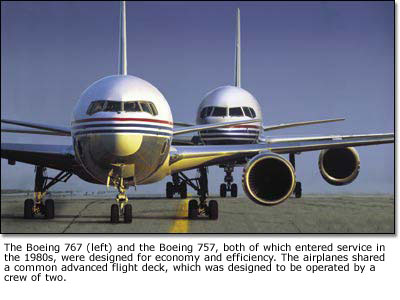| 
CENTURY OF FLIGHT:1981–1990
High technolgy and new frontiers
BY MIKE LOMBARDI

 The
1980s was a decade of high technology and new frontiers symbolized by
the Space Shuttle, stealth planes, advanced computers that helped pilots
to fly, and a plan to build a space based missile shield that would bankrupt
a nation and end the Cold War. The
1980s was a decade of high technology and new frontiers symbolized by
the Space Shuttle, stealth planes, advanced computers that helped pilots
to fly, and a plan to build a space based missile shield that would bankrupt
a nation and end the Cold War.
Fuel efficiency was the watchword for commercial aviation's next generation
of airplanes. Boeing built the 767, which entered service in 1982, and
the Boeing 757, which began service in 1983, for economy, designing them
around large high-bypass turbofan engines and an advanced-technology wing.
The airplanes pioneered the concept of commonality by using many common
parts and sharing a common advanced flight deck. The advanced flight deck
of the 757 and 767 was designed to be operated by a crew of two and featured
a computerized, fully integrated, flight management system and digital
electronic displays.
A number of new planes would follow, including the 737-300/400/500, the
747-400, the McDonnell Douglas MD-80/90 series and the A310 and A320 series
from Airbus.
On April 21, 1981, decades of research into a reusable spacecraft finally
became a reality when the Shuttle Orbiter Columbia made its first of four
orbital flight tests. The Space Shuttle had its first operational mission
in November 1982, when Columbia deployed two communications satellites.
The Shuttle program quickly made important contributions to scientific
research and also showed the feasibility of working in space. The program
also achieved historic milestones when Sally Ride became the first American
woman to fly into space on STS-7 and on the next mission Guy Bluford Jr.
became the first African American in space.
The successful Shuttle program came to a tragic halt on Jan. 28, 1986,
with the loss of Orbiter Challenger and its crew seconds after lift off.
A two-year-long investigation found that the failure of a pressure seal
in one of the solid rocket boosters was to blame. With the conclusion
of the investigation and modifications to the booster the Shuttle program
was ready to start again and on Sept. 30, 1988, Discovery returned to
space.
During the 1980s, the Reagan Administration focused military aviation
and space technology toward winning the Cold War. A previous decision
to cancel the long-running B-1 program was reversed, giving the Strategic
Air Command a high-speed airborne deterrent. Terrain-following, air-launched
cruise missiles were put into production, giving both the Boeing B-52
and the North American B-1 long-range nuclear strike capability.
Along with these programs, the United States also invested in super secret,
high-technology programs called “black” programs. One of the
best known is the development of radar-evading or “stealth”
technology that resulted in the Northrop B-2 Spirit, also known as the
“Stealth Bomber.”
Another defense program that gained a great deal of publicity because
of its ambitious goals and high cost was the Strategic Defense Initiative,
popularly known as “Star Wars.” SDI was to be a space-based
missile shield that would defend the world, including the Soviet Union,
from the threat of nuclear-armed ballistic missiles. The Soviet Union
efforts to maintain parity or counter all of these technological advances,
especially SDI, came at too high of a cost for the Soviet economy, ultimately
contributing to the collapse of the Soviet Union and an end to the Cold
War.
Even in the high-tech era of the 1980s, there was still room for old fashioned
aviation pioneers who conquered records. Richard “Dick” Rutan,
a visionary designer of unique experimental aircraft as well as the Beech
Starship, designed and built the Voyager, an all-composite, extremely
fuel-efficient, twin-engine airplane. In December 1986, Voyager carried
Bert Rutan (Dick's brother) and Jeana Yeageron a 24,986-mile journey that
was the first non-stop, un-refueled, around-the-world flight.
michael.j.lombardi@boeing.com
|